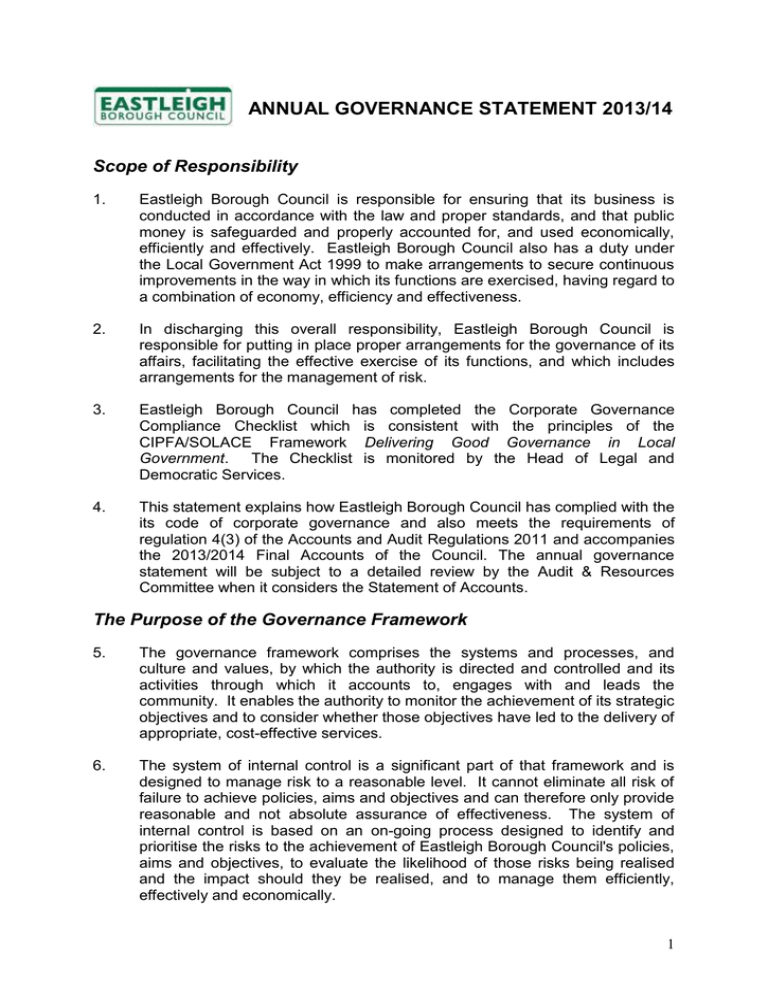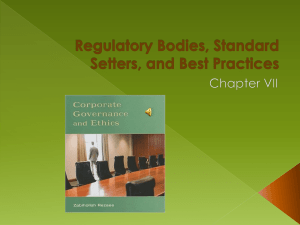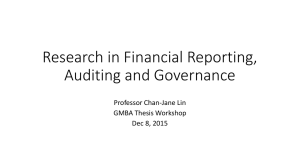Annual Governance Statement 2013/14
advertisement

ANNUAL GOVERNANCE STATEMENT 2013/14 Scope of Responsibility 1. Eastleigh Borough Council is responsible for ensuring that its business is conducted in accordance with the law and proper standards, and that public money is safeguarded and properly accounted for, and used economically, efficiently and effectively. Eastleigh Borough Council also has a duty under the Local Government Act 1999 to make arrangements to secure continuous improvements in the way in which its functions are exercised, having regard to a combination of economy, efficiency and effectiveness. 2. In discharging this overall responsibility, Eastleigh Borough Council is responsible for putting in place proper arrangements for the governance of its affairs, facilitating the effective exercise of its functions, and which includes arrangements for the management of risk. 3. Eastleigh Borough Council has completed the Corporate Governance Compliance Checklist which is consistent with the principles of the CIPFA/SOLACE Framework Delivering Good Governance in Local Government. The Checklist is monitored by the Head of Legal and Democratic Services. 4. This statement explains how Eastleigh Borough Council has complied with the its code of corporate governance and also meets the requirements of regulation 4(3) of the Accounts and Audit Regulations 2011 and accompanies the 2013/2014 Final Accounts of the Council. The annual governance statement will be subject to a detailed review by the Audit & Resources Committee when it considers the Statement of Accounts. The Purpose of the Governance Framework 5. The governance framework comprises the systems and processes, and culture and values, by which the authority is directed and controlled and its activities through which it accounts to, engages with and leads the community. It enables the authority to monitor the achievement of its strategic objectives and to consider whether those objectives have led to the delivery of appropriate, cost-effective services. 6. The system of internal control is a significant part of that framework and is designed to manage risk to a reasonable level. It cannot eliminate all risk of failure to achieve policies, aims and objectives and can therefore only provide reasonable and not absolute assurance of effectiveness. The system of internal control is based on an on-going process designed to identify and prioritise the risks to the achievement of Eastleigh Borough Council's policies, aims and objectives, to evaluate the likelihood of those risks being realised and the impact should they be realised, and to manage them efficiently, effectively and economically. 1 7. The governance framework has been in place at Eastleigh Borough Council for the year ended 31 March 2014 and up to the date of the approval of the 2013/2014 Statement of Accounts. The Governance Framework 8. 9. Our governance framework derives from six core principles identified in a 2004 publication entitled The Good Governance Standard for Public Services. This was produced by the Independent Commission on Good Governance in Public Services - a commission set up by the Chartered Institute of Public Finance and Accountancy (CIPFA), and the Office of Public Management. The Commission utilised work done by, amongst others, Cadbury (1992), Nolan (1995) and CIPFA/SOLACE (2001). These principles were adapted for application to local authorities and published by CIPFA in 2007. The six core principles are: 8.1 focusing on the purpose of the authority and on outcomes for the community and creating and implementing a vision for the local area; 8.2 members and officers working together to achieve a common purpose with clearly defined functions and roles; 8.3 promoting values for the authority and demonstrating the values of good governance through upholding high standards of conduct and behaviour; 8.4 taking informed and transparent decisions which are subject to effective scrutiny and managing risk; 8.5 developing the capacity and capability of members and officers to be effective; and 8.6 engaging with local people and other stakeholders to ensure robust public accountability. The Council is undertaking the following in respect of these core principles: 9.1 2 Focusing on the purpose of the authority and on outcomes for the community and creating and implementing a vision for the local area 9.1.1 The Council's Corporate Plan sets out our aims and key priorities for the area and the actions we propose to take to achieve them. It provides the focus for the development of our service plans and our action plans for staff - the people who ultimately put the strategy into action. 9.1.2 The Plan is driven by our primary purpose to improve the quality of life for all local people. Consequently, the wide range of initiatives included in the strategy has evolved from work with many people: Our communities Our partners Our staff Our elected councillors 9.1.3 The Cabinet receives an annual medium term financial strategy covering a four-year period, which is used to set initial parameters for the coming budget process. 9.1.4 We are committed to encouraging all members of the local communities to contribute to, and participate in, the work of the Council. We regularly seek the views of Eastleigh Borough Residents through "Viewpoint", a programme of surveys conducted by the Council using its Citizens' Panel, which comprises 800 to 1,000 residents on rotational basis. 9.1.5 The list below sets out the various links in the process of establishing and monitoring the achievements of the Council's ambitions, and shows the links between the Community and Council plans which then feed into, and are informed by, service plans, service targets and individual employees via specific areas of responsibility allocated to them: Corporate Plan; Themed Strategies & Plans; Business Unit Plans and Targets; Council Priorities. The Council has a Performance Management Framework which is constantly reviewed. The Council utilises a dedicated IT system (QPR) to record, monitor and report upon performance management information. The system is driven by the Corporate Plan which focuses attention on Council ambitions, priorities and the targets set in the Local Area Agreement (this sets out the priorities for a local area agreed between central government, the Council and other key partners). This is cascaded through Unit Business Plans, individual employee appraisals and action plans. 9.1.6 Management Team, the Cabinet and Policy and Performance Scrutiny Panel monitor and scrutinise progress against targets and performance in priority areas affecting relevant service areas, and consider and approve or recommend corrective action where necessary. This reporting is undertaken using a traffic light system so as to 3 make interpretation of the results easier. 4 9.1.7 The reporting process is under constant review in order to develop its maximum potential, and we are continuing to explore ways in which the financial information can be more closely linked to the service performance information. 9.1.8 The Council maintains an objective and professional relationship with external auditors and statutory inspectors, as evidenced by the Annual Audit Letter. 9.1.9 Through reviews by external auditors, external agencies, Internal Audit, and internal review teams, the Council constantly seeks ways of ensuring the economical, effective and efficient use of resources, and for securing continuous improvement in the way in which its functions are exercised. 9.1.10 The Council's Corporate Procurement Strategy provides a consistent strategic framework within which to undertake and continuously develop procurement to deliver the Council's corporate objectives, to improve performance and deliver efficiencies. The Strategy encompasses the policy objectives of the National Procurement Strategy and adapts and prioritises them to meet the Council's local context. The Strategy recognises that the Council cannot achieve its objectives alone and emphasises the need to work in collaboration with public, private, social enterprise and voluntary sector partners. A core theme throughout the Strategy is the Council's commitment to social, economic and environmental sustainability. This is a priority throughout the whole procurement life cycle. 9.1.11 Risk Management is monitored by the Strategic Risk Management Group (SRMG), the group has recently been reviewed by senior management and significant changes in their effectiveness are in progress with resource changes planned for 2014/15. The Group reviews risk arrangements and advises Management Team and the Audit and Resources Committee on risk issues within the Council and on existing and planned risk controls. 9.1.12 Risks are reported by use of risk registers. Each unit is required to regularly update its own register as part of the performance management process. In addition, a corporate register exists to record high level risks which affect the work of several units or the whole Council. 9.1.13 A revised Risk Management User Guide is under review and will be published in 2014/15. 9.2 Members and Officers working together to achieve a common purpose with clearly defined functions 9.2.1 The Council has adopted a Constitution which sets out how the Council operates, how decisions are made and the procedures which are followed to ensure these are efficient, transparent and accountable to local people. The Constitution reflects the "Leader and Cabinet" model following the Local Government Act 2000. 9.2.2 The main decision-making committee is the Cabinet, which is responsible for all executive matters as defined by law and operates within the budget and policy framework approved annually by Council. Meetings are open to the public except where personal or confidential matters are being discussed. In addition, senior and other officers of the Council can make decisions under delegated authority - again the extent of these delegations is set out in the Constitution. The Council publishes a forward plan which contains details of key decisions to be made by the Cabinet and, occasionally, other committees. Each Cabinet member has a specific portfolio of responsibilities requiring them to work closely with senior and other employees so as to achieve the Council's ambitions. The Council has not adopted individual decisionmaking powers for the portfolio holders, with a couple of exceptions as detailed in the Constitution. 9.2.3 Management Team meets on a regular basis to develop policy issues commensurate with the Council's aims, objectives, and priorities. Management Team also considers other internal control issues, including risk management, performance management, compliances, efficiency and value for money, and financial management. Management Team meets with Cabinet members on a monthly basis ("Management Liaison") to review progress in achieving the Council's ambitions, priorities for action, performance management and forward planning for major issues. 9.2.4 The management scheme of delegation was reviewed in 2008, and republished as Management Responsibilities and Delegation. 9.2.5 The Council's Unit Heads receive a fortnightly briefing from a member of Management Team on key issues happening in and around the Council. Additionally, there is a more interactive monthly "Senior Managers Group" meeting where two or three significant topics of current concern to the Council can be explored in more depth and shared approaches agreed. The nature of Senior Managers Group 5 means that every Unit gets involved in corporate and strategic issues, and has ownership of what is decided. 9.2.6 In addition there are specific groups established to progress issues on a corporate basis as well as lunch and learn sessions relayed to all staff on an informal basis. 9.2.7 The most significant are the programme boards which oversee the implementation of a portfolio of linked projects. A Project Management Forum has been set up to empower development of project management further across the Council. 9.2.8 Specific groups include: GROUP CIP Programme Board ICT Programme Board Customer Service Centre (CSC) Project Board Strategic Risk Management Group PRINCIPAL OBJECTIVES Oversees capital investment in Regeneration, Infrastructure and Leisure. To oversee ICT developments and pursue greater integration of services within the CSC. To progress the development of the CSC in terms of service areas covered, so as to enhance the customer experience and develop greater consistency of service provision. To raise the level of management awareness and accountability for service risks identified by the Group. To develop risk management as part of the culture of the Council. To provide a mechanism for risk management issues to be discussed and disseminated to all areas of the Council. To prioritise and accelerate the risk management strategy recommendations which are critical to the achievement of corporate objectives. To advise the Audit and Resources Committee on risk issues within the Council and on existing and planned risk controls. 6 ICT Security Group Procurement Executive Group To overview arrangements of the Safety Advisory Group (SAG). The purpose of the Group is to minimise risk to the Council, its customers and partner agencies from accidental or intentional loss or misuse of data or misuse of IT systems. Review, implement and monitor the Council's procurement rules and procedures. Agree variations to Contract Standing Orders. Oversee: The introduction of eprocurement; The procurement strategy; The contracts register; The procurement guidance. Property Transactions Evaluations Group Treasury Management Groups Officers Members Equalities and Diversity Working Group Advise on procurement matters, identify and promote improvements and support the procurement process generally. Evaluates/considers property transactions and monitoring. Sets strategies; Conducts the treasury management portfolio. Development of policies, practices and procedures in relation to: Service planning and delivery; Employment issues; Ensuring effective communication. Development and monitoring of service equality action plans. 9.2.9 The Council has also adopted a number of codes and protocols that will govern both member and officer activities. These are: 7 9.2.9.1 9.2.9.2 9.2.9.3 9.2.9.4 9.2.9.5 9.2.9.6 9.3 8 Members Code of Conduct (revised under the Localism Act) Protocol on Councillor/Staff Relations Code of Conduct for Members and Officers regarding planning matters Members' Declarations of Interest Member/Officer relations Gifts and hospitality Promoting values for the authority and demonstrating the values of good governance through upholding high standards of conduct and behaviour 9.3.1 The Council has designated the Head of Legal and Democratic Services as the Monitoring Officer. It is the function of the Monitoring Officer to ensure compliance with established policies, procedures, laws and regulations. After consulting the Chief Executive he will report to the Council if he considers that any proposal, decision or omission would give rise to unlawfulness or maladministration. Such a report will have the effect of stopping the proposal or decision implemented until the report has been considered. 9.3.2 The Council ensures that its services are delivered by trained, competent and experienced people. All posts have a detailed Role Profile and Person Specification. Training needs are identified on an on-going basis (eg, weekly, 1:1 meetings) and also through the Annual Individual Performance Review. 9.3.3 The financial management of the Authority is conducted in accordance with the financial rules set out in Parts 2 and 4 of the Constitution and with Financial Regulations. In December 2013 the Council elected a new Chief Financial Officer in accordance with Section 151 of the Local Government Act 1972. The Council has in place a four-year Financial Strategy, updated annually, to support the mediumterm aims of the Corporate Plan. 9.3.4 The Council maintains an Internal Audit section, which operates to the standards set out in the Code of Practice for Internal Audit in Local Government in the UK. This section continues to operate under a partnership arrangement with Gosport Borough Council and Test Valley Borough Council. 9.3.5 Individual Units have produced Business Plans which are updated each year so as to incorporate the Corporate Plan requirements into service activities, and so that services know what they are required to do to achieve the Council's priorities and ambitions. governance impact. 9.4 These plans also identify any Taking informed and transparent decisions which are subject to effective scrutiny and managing risk 9.4.1 The Council has several committees which carry out regulatory or scrutiny functions. Currently some minor revisions to the committee structure are being worked up and implemented, the implications of which are as follows: 9.4.1.1 the five Local Area Committees remain in place to determine planning applications and related matters and to take all other decisions at a local level whenever this can be done (eg, in respect of traffic schemes, community initiatives, youth issues); 9.4.1.2 an Administration Committee which promotes, monitors and enforces probity and high ethical standards amongst the Council's Members, including monitoring of the Council’s Code of Conduct, with the same responsibility for all town and parish councils with the Borough; as well as having responsibility for regulatory matters which cannot by law be the responsibility of the Cabinet (e.g. taxi licensing and electoral matters); 9.4.1.3 an Audit and Resources Committee to provide assurance about the adequacy of internal controls, financial accounting and reporting arrangements, and that effective risk management is in place. Its work is intended to enhance public trust in the corporate and financial governance of the Council; 9.4.1.4 a Licensing Committee, which monitors and reviews the effectiveness of the Council's licensing policy and procedures, in respect of the Licensing Act 2003 and Gambling Act 2005; 9.4.1.5 a scrutiny panel which reviews and scrutinises decisions made or actions taken in connection with the discharge of any of the Council's functions. Task and Finish Groups can be established by the scrutiny panel to undertake specific pieces of work including policy development and looking at improved ways of working. 9 9.5 9.6 10 Developing the capacity and capability of members and officers to be effective 9.5.1 Member development is kept under constant review and training is provided on a needs basis. Awareness training has been provided in the production of the Annual Accounts as well as explain the difference in private and public sector accounting. There is more finance specific training to Members planned for 2014/15. 9.5.2 All staff receive an annual Individual Performance Review with their Line Manager. This serves as a review of achievements, addresses any areas of concern and provides an opportunity to consider future objectives and to devise a Personal Development Plan. Training and support needs are considered at these meetings. 9.5.3 An electronic document and records management system is operating throughout the Council to enable all Units to manage its own information and data, plus other knowledge material. This is part of the coherent, co-ordinated knowledge and information management strategy designed to enhance the accessibility, value and usefulness of the corporate resource that information, data and knowledge represents. Engaging with local people and other stakeholders to ensure robust public accountability 9.6.1 The Council actively encourages public participation at all its meetings with a 15 minute "open" session at the start, so that issues of concern that fall within the remit of that meeting can be aired. There is then the opportunity for the public to ask questions, give support to or raise concern on specific agenda items as they are dealt with. In addition, a community engagement strategy is being developed and the Council’s website has been updated to include community issues. 9.6.2 Much of the work the Council undertakes is done with public consultation at a level appropriate to the situation. The Council has a proven track record of working well in partnership with the parish and town councils in the area. 9.6.3 The Council also produces a number of very popular publications that help and assist residents. These include the pocket-sized A-Z of Council Services and the Street Guide. Residents can also receive SMS text alerts to advise them on Council initiatives and local activities. The Council's website is updated regularly and contains a wealth of information on the Council and work in which it is involved. 9.6.4 The Council is also transparent in the way it offers a right of recourse to staff and the public. The Council's Whistleblowing Procedure and formal Complaints Procedure are publicised on the Councils web site. Review of Effectiveness 10. The Council has responsibility for conducting, at least annually, a review of the effectiveness of its governance framework including the system of internal control. 11. The next paragraphs give more detail regarding the actual review process and actions undertaken during the current period. 12. The review of effectiveness is informed by the work of the managers within the Council who have responsibility for development and maintenance of the governance environment, the Head of Internal Audit's annual report and also by comments made by the external auditors and other review agencies and inspectorates. 13. The process that has been applied in maintaining and reviewing the effectiveness of the governance framework includes: 13.1 The financial management arrangements of the Council conform to the CIPFA 2010 statement on the role of the Chief Financial Officer. 13.2 The Head of Legal and Democratic Services (the "Monitoring Officer") has a duty to monitor and review the operation of the Constitution to ensure its aims and principles are given full effect. The Council reviews the Constitution regularly to incorporate any necessary changes. 13.3 The Local Area Committee structure means that the Council can take decisions at a local level. The meetings are held in the areas they cover and public attendance is usually higher than if such meetings were all held in the Civic Offices. 13.4 Members can "call-in" a decision (also known as a "Minority Order") which has been made but not yet implemented, to enable it to consider whether the decision is appropriate. This is set out in detail in Paragraphs 23.2 to 23.6 of Part 4 of the Constitution, which can be found on the Council’s website. 11 12 13.5 Internal Audit is responsible for monitoring the quality and effectiveness of systems of internal control. A risk model is used to formulate a three-year plan, from which the annual workload is identified. The reporting process for Internal Audit requires a report of each audit to be submitted to the relevant service head and/or corporate director and chief executive. The report includes recommendations for improvements that are included within an action plan (and regarded as critical, essential, important and advisory) and requires agreement by service heads and/or corporate directors and chief executive. The process includes follow-up reviews of recommendations to ensure that they are acted upon, usually within six months. 13.6 Full details of the Audit and Resources Committee and the business conducted can be found on the Council website under the committee meetings section. Governance Issues 14. The following governance issues were identified during 2013/14 as a result of the review of arrangements and by the work of external and internal audit and progress to date is detailed below. ISSUE ACTION / PROGRESS TO DATE To ensure Internal Audit continue to support the business process reengineering timetable and sign off new systems as developed by the business analyst and respective service heads. To ensure dedicated Internal Audit resource availability. The Council should continue to review the affordability and financing of its extensive capital programme including potential risks posed by changing economic circumstances. Close scrutiny by both internal and external audit in these areas. Management need to continue monitoring their control environment as the pace of organisational change increases throughout the Council. Internal Audit, in support with management will continue to review key areas of the Council in which staff turnover may affect the current operating controls. That the risk management function is reviewed, in light of criticism from External Audit and given sufficient resources to be more effective to the Council. A comprehensive review has established that this function now be transferred to the Project Accountant within the Finance Unit. Improvements in both effectiveness and transparency will be monitored by senior management, Members and External Audit over 2014/15. On-going task. The relocation of the Civic Offices to A Project Board has been set up Eastleigh House. to oversee the relocation and the refurbishment work at Eastleigh House. Internal Audit are playing an active role to support this key project. Completed 13 We propose over the coming year to take steps to address the above matters to further enhance our governance arrangements. We are satisfied that these steps will address the need for improvements that were identified in our review of effectiveness and will monitor their implementation and operation as part of our next annual review. . Signed: 14 …………………………… …………………………… Councillor Keith House Leader of the Council Nick Tustian Chief Executive Date: Date:







